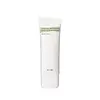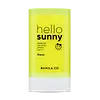B.LAB Matcha Hydrating Real Sun Screen SPF 50+ Versus Banila Co Hello Sunny Essence Sun Stick SPF 50+
What's inside
What's inside
 Key Ingredients
Key Ingredients

 Benefits
Benefits

 Concerns
Concerns

 Ingredients Side-by-side
Ingredients Side-by-side

Water
Skin ConditioningPropanediol
SolventEthylhexyl Salicylate
UV AbsorberHomosalate
Skin ConditioningDibutyl Adipate
EmollientGlycerin
HumectantCyclopentasiloxane
EmollientNiacinamide
SmoothingBis-Ethylhexyloxyphenol Methoxyphenyl Triazine
Skin ConditioningMethylene Bis-Benzotriazolyl Tetramethylbutylphenol
UV FilterPolysilicone-15
UV FilterDiethylamino Hydroxybenzoyl Hexyl Benzoate
UV FilterCamellia Sinensis Leaf Extract
AntimicrobialMesembryanthemum Crystallinum Extract
HumectantPolymethylsilsesquioxane
Mentha Viridis Extract
MaskingMentha Aquatica Extract
TonicMentha Rotundifolia Leaf Extract
TonicSodium Hyaluronate
Humectant1,2-Hexanediol
Skin ConditioningPentylene Glycol
Skin ConditioningPoly C10-30 Alkyl Acrylate
Emulsion StabilisingBehenyl Alcohol
EmollientVp/Eicosene Copolymer
Silica
AbrasivePolyglyceryl-3 Methylglucose Distearate
EmulsifyingTromethamine
BufferingButylene Glycol
HumectantDecyl Glucoside
CleansingCarbomer
Emulsion StabilisingAcrylates/C10-30 Alkyl Acrylate Crosspolymer
Emulsion StabilisingSodium Stearoyl Glutamate
CleansingEthylhexylglycerin
Skin ConditioningPolyacrylate Crosspolymer-6
Emulsion StabilisingAdenosine
Skin ConditioningSodium Polyacrylate
AbsorbentPropylene Glycol
HumectantPolyether-1
Xanthan Gum
EmulsifyingT-Butyl Alcohol
PerfumingWater, Propanediol, Ethylhexyl Salicylate, Homosalate, Dibutyl Adipate, Glycerin, Cyclopentasiloxane, Niacinamide, Bis-Ethylhexyloxyphenol Methoxyphenyl Triazine, Methylene Bis-Benzotriazolyl Tetramethylbutylphenol, Polysilicone-15, Diethylamino Hydroxybenzoyl Hexyl Benzoate, Camellia Sinensis Leaf Extract, Mesembryanthemum Crystallinum Extract, Polymethylsilsesquioxane, Mentha Viridis Extract, Mentha Aquatica Extract, Mentha Rotundifolia Leaf Extract, Sodium Hyaluronate, 1,2-Hexanediol, Pentylene Glycol, Poly C10-30 Alkyl Acrylate, Behenyl Alcohol, Vp/Eicosene Copolymer, Silica, Polyglyceryl-3 Methylglucose Distearate, Tromethamine, Butylene Glycol, Decyl Glucoside, Carbomer, Acrylates/C10-30 Alkyl Acrylate Crosspolymer, Sodium Stearoyl Glutamate, Ethylhexylglycerin, Polyacrylate Crosspolymer-6, Adenosine, Sodium Polyacrylate, Propylene Glycol, Polyether-1, Xanthan Gum, T-Butyl Alcohol
Octyldodecanol
EmollientPropylheptyl Caprylate
EmollientOctocrylene
UV AbsorberButylene Glycol Dicaprylate/Dicaprate
EmollientEthylhexyl Methoxycinnamate
UV AbsorberDicaprylyl Carbonate
EmollientDibutyl Lauroyl Glutamide
Skin ConditioningEthylhexyl Salicylate
UV AbsorberDextrin Palmitate
EmulsifyingDibutyl Ethylhexanoyl Glutamide
Skin ConditioningDiethylamino Hydroxybenzoyl Hexyl Benzoate
UV FilterBis-Ethylhexyloxyphenol Methoxyphenyl Triazine
Skin ConditioningSilica Silylate
EmollientTocopheryl Acetate
AntioxidantBisabolol
MaskingCitrus Aurantium Dulcis Oil
MaskingLavandula Angustifolia Oil
MaskingCitrus Nobilis Peel Oil
MaskingDehydroacetic Acid
PreservativeEchium Plantagineum Seed Oil
Skin ConditioningLitsea Cubeba Fruit Oil
MaskingAnthemis Nobilis Flower Oil
MaskingHelianthus Annuus Seed Oil Unsaponifiables
EmollientCardiospermum Halicacabum Flower/Leaf/Vine Extract
Skin ConditioningTocopherol
AntioxidantWater
Skin ConditioningBetula Alba Juice
AstringentButylene Glycol
HumectantOenothera Biennis Flower Extract
Astringent1,2-Hexanediol
Skin ConditioningHypnea Musciformis Extract
Skin ProtectingUlva Lactuca Extract
Skin ConditioningEcklonia Cava Extract
Skin ConditioningCodium Tomentosum Extract
Skin ProtectingAgarum Cribrosum Extract
Skin ConditioningEnteromorpha Compressa Extract
Skin ProtectingLaminaria Japonica Extract
Skin ProtectingDunaliella Salina Extract
Skin ConditioningSargassum Fulvellum Extract
Skin ConditioningSargassum Muticum Extract
Skin ProtectingPorphyra Tenera Extract
Skin ConditioningSpirulina Platensis Extract
Skin ProtectingJania Rubens Extract
Skin ConditioningGelidium Cartilagineum Extract
Skin ProtectingEuglena Gracilis Extract
Skin ConditioningMacrocystis Pyrifera Extract
Skin ConditioningUndaria Pinnatifida Extract
Skin ConditioningCodium Fragile Extract
Skin ConditioningLaminaria Cloustoni Extract
Skin ProtectingCladosiphon Okamuranus Extract
Skin ConditioningChlorella Vulgaris Extract
Skin ConditioningSalicornia Herbacea Extract
Skin ConditioningPhenoxyethanol
PreservativePlankton Extract
Skin ConditioningPikea Robusta Extract
AntioxidantHydrolyzed Ulva Lactuca Extract
Skin ConditioningHaematococcus Pluvialis Extract
AntioxidantLaminaria Digitata Extract
Skin ProtectingDisodium EDTA
Ethylhexylglycerin
Skin ConditioningMacrocystis Pyrifera Protein
Skin ConditioningHydrolyzed Enteromorpha Compressa
Skin ConditioningOctyldodecanol, Propylheptyl Caprylate, Octocrylene, Butylene Glycol Dicaprylate/Dicaprate, Ethylhexyl Methoxycinnamate, Dicaprylyl Carbonate, Dibutyl Lauroyl Glutamide, Ethylhexyl Salicylate, Dextrin Palmitate, Dibutyl Ethylhexanoyl Glutamide, Diethylamino Hydroxybenzoyl Hexyl Benzoate, Bis-Ethylhexyloxyphenol Methoxyphenyl Triazine, Silica Silylate, Tocopheryl Acetate, Bisabolol, Citrus Aurantium Dulcis Oil, Lavandula Angustifolia Oil, Citrus Nobilis Peel Oil, Dehydroacetic Acid, Echium Plantagineum Seed Oil, Litsea Cubeba Fruit Oil, Anthemis Nobilis Flower Oil, Helianthus Annuus Seed Oil Unsaponifiables, Cardiospermum Halicacabum Flower/Leaf/Vine Extract, Tocopherol, Water, Betula Alba Juice, Butylene Glycol, Oenothera Biennis Flower Extract, 1,2-Hexanediol, Hypnea Musciformis Extract, Ulva Lactuca Extract, Ecklonia Cava Extract, Codium Tomentosum Extract, Agarum Cribrosum Extract, Enteromorpha Compressa Extract, Laminaria Japonica Extract, Dunaliella Salina Extract, Sargassum Fulvellum Extract, Sargassum Muticum Extract, Porphyra Tenera Extract, Spirulina Platensis Extract, Jania Rubens Extract, Gelidium Cartilagineum Extract, Euglena Gracilis Extract, Macrocystis Pyrifera Extract, Undaria Pinnatifida Extract, Codium Fragile Extract, Laminaria Cloustoni Extract, Cladosiphon Okamuranus Extract, Chlorella Vulgaris Extract, Salicornia Herbacea Extract, Phenoxyethanol, Plankton Extract, Pikea Robusta Extract, Hydrolyzed Ulva Lactuca Extract, Haematococcus Pluvialis Extract, Laminaria Digitata Extract, Disodium EDTA, Ethylhexylglycerin, Macrocystis Pyrifera Protein, Hydrolyzed Enteromorpha Compressa
 Reviews
Reviews

Ingredients Explained
These ingredients are found in both products.
Ingredients higher up in an ingredient list are typically present in a larger amount.
1,2-Hexanediol is a synthetic liquid and another multi-functional powerhouse.
It is a:
- Humectant, drawing moisture into the skin
- Emollient, helping to soften skin
- Solvent, dispersing and stabilizing formulas
- Preservative booster, enhancing the antimicrobial activity of other preservatives
You might know this ingredient as Tinosorb S or Bemotrizinol. It is a UV filter that covers both UVA and UVB rays.
This ingredient has two peak UV absorption peaks ( 310 and 340 nm) and is able to absorb both UV-A and UV-B rays. This ingredient works by preventing UV rays from reaching and damaging your skin.
On top of that - it is highly photostable and helps prevent the photodegration of other sunscreen ingredients such as avobenzone.
Tinosorb S is allowed in the EU, Australia, and Asia. It is close to being approved by the FDA and we'll hopefully get this ingredient in the U.S. by late 2025.
Fun fact: Tinosorb S is the most effective UV absorber at maximum concentration (measured by SPF) permitted in the EU.
This ingredient is oil-soluble, so your oil-cleansers will take this right off at night.
Learn more about Bis-Ethylhexyloxyphenol Methoxyphenyl TriazineButylene Glycol (or BG) is used within cosmetic products for a few different reasons:
Overall, Butylene Glycol is a safe and well-rounded ingredient that works well with other ingredients.
Though this ingredient works well with most skin types, some people with sensitive skin may experience a reaction such as allergic rashes, closed comedones, or itchiness.
Learn more about Butylene GlycolDiethylamino Hydroxybenzoyl Hexyl Benzoate (DHHB) is a chemical UV-A absorber. It is formulated for high UVA protection (320-400 nm).
DHHB is well-liked for:
DHHB has been approved by the EU, Japan, Taiwan, and South America for use up to 10%. Unfortunately, it has not been approved for use in the US or Canada due to slow regulatory processes.
This ingredient is soluble in oils, fats, and lipids.
Learn more about Diethylamino Hydroxybenzoyl Hexyl BenzoateEthylhexyl Salicylate is an organic compound used to block UV rays. It primarily absorbs UVB rays but offers a small amount of UVA protection as well.
Commonly found in sunscreens, Ethylhexyl Salicylate is created from salicylic acid and 2-ethylhexanol. You might know salicylic acid as the effective acne fighter ingredient and BHA.
The ethylhexanol in this ingredient is a fatty alcohol and helps hydrate your skin, similar to oils. It is an emollient, which means it traps moisture into the skin.
According to manufacturers, Ethylhexyl Salicylate absorbs UV wavelength of 295-315 nm, with a peak absorption at 307-310 nm. UVA rays are linked to long term skin damage, such as hyperpigmentation. UVB rays emit more energy and are capable of damaging our DNA. UVB rays cause sunburn.
Learn more about Ethylhexyl SalicylateEthylhexylglycerin (we can't pronounce this either) is commonly used as a preservative and skin softener. It is derived from glyceryl.
You might see Ethylhexylglycerin often paired with other preservatives such as phenoxyethanol. Ethylhexylglycerin has been found to increase the effectiveness of these other preservatives.
Water. It's the most common cosmetic ingredient of all. You'll usually see it at the top of ingredient lists, meaning that it makes up the largest part of the product.
So why is it so popular? Water most often acts as a solvent - this means that it helps dissolve other ingredients into the formulation.
You'll also recognize water as that liquid we all need to stay alive. If you see this, drink a glass of water. Stay hydrated!
Learn more about Water